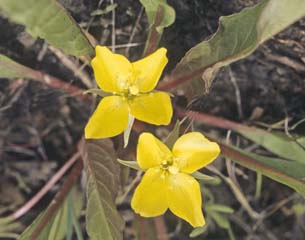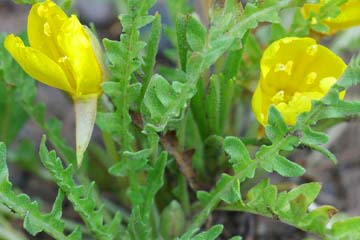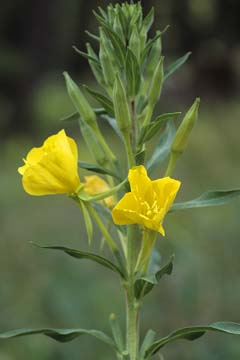 |
Northern suncup, Camissonia
subacaulis (Pursh) P. H.
Raven (left) is a low-growing, four-petaled summer plant
found only on moist ground. The name, subacaulis, means “not
much of a stem,” referring to the flowers, for the flower’s
“stem” is actually part of the flower tube and the stem itself
is very short. The plant was first collected by Meriwether Lewis on the Weippe
Prairie in northern Idaho on June 14, 1806. Camissonia honors German
botanist, novelist, and composer Adelbert von Chamisso
(1781-1838) a member of the Russian Kotzebue Pacific expedition of 1815-1818.
Tansy-leaved suncup, Camissonia
tanacetifolia
(Torr. & A. Gray) P. H. Raven (right). The
tansy-leaved suncup’s growth habit is similar to that of the northern
suncup and it has a similar range, although, in Idaho at least, it seems
to be less common. It is characterized by pinnate leaves that are rather
like those of the common tansy (Tanacetum vulgare) explaining both
its common and scientific species names. |
 |
 |
Common evening-primrose, Oenothera
villosa Thunb. var. strigosa (Rydb.) Dorn
left) was until recently classified as Oenothera
strigosa. Several varieties are recognized; ours is found mostly in the
Rocky Mountains (the species name, villosa, and the variety name,
strigosa, both imply that the plant is covered with fine hairs) growing
at least as high as the montane zone. Like the rock-rose (right) this plant
has a showy flower whose blooms last but a day. It is usually found in open
meadows where it can be identified by its alternate lanceolate leaves, four
large yellow petals and reflexed (bent downward) sepals.
Rock-rose, Oenothera cespitosa Nutt.
var. cespitosa (right), known by many other local
names, is a wide-ranging western plant and other varieties are recognized.
It flowers during the summer and is often found high in our mountains growing
on dry, sandy slopes. Oenotheras bloom at night when moth-pollinators are
active, and by the next afternoon the flowers have wilted—today’s
and yesterday’s flowers are present in the illustration. The species
name is properly spelled caespitosa (it means “tufted”).
Our spelling, cespitosa, is correct for this plant, however, as Thomas
Nuttall spelled it that way in describing it. According to the rules of botanical
nomenclature the first published name establishes the correct orthography
for a plant. |
 |
 |
Pale evening-primrose, Oenothera
pallida Lindl. (left) is
a foothills plant. Like the rock-rose, it prefers dry, sandy soil. The plants
are easily identified by their nodding, elongated, reddish-brown buds,
by their linear to lanceolate leaves and by their showy white flowers.
The plants are found throughout the West, from British Columbia to Texas,
(although apparently not in California). Four varieties are recognized; ours
is var. pallida. |




